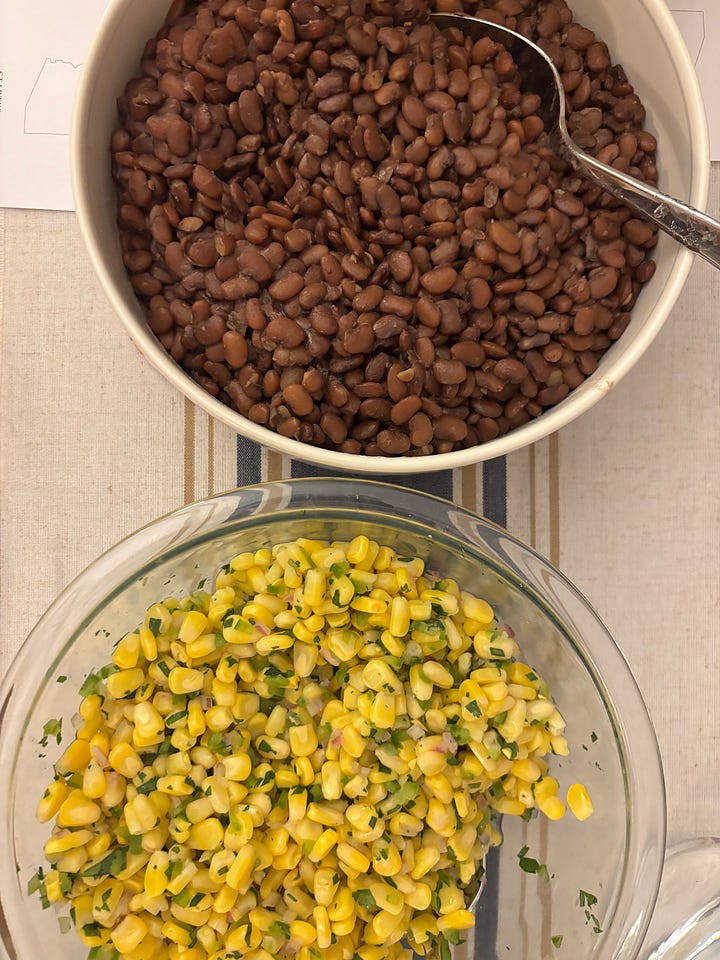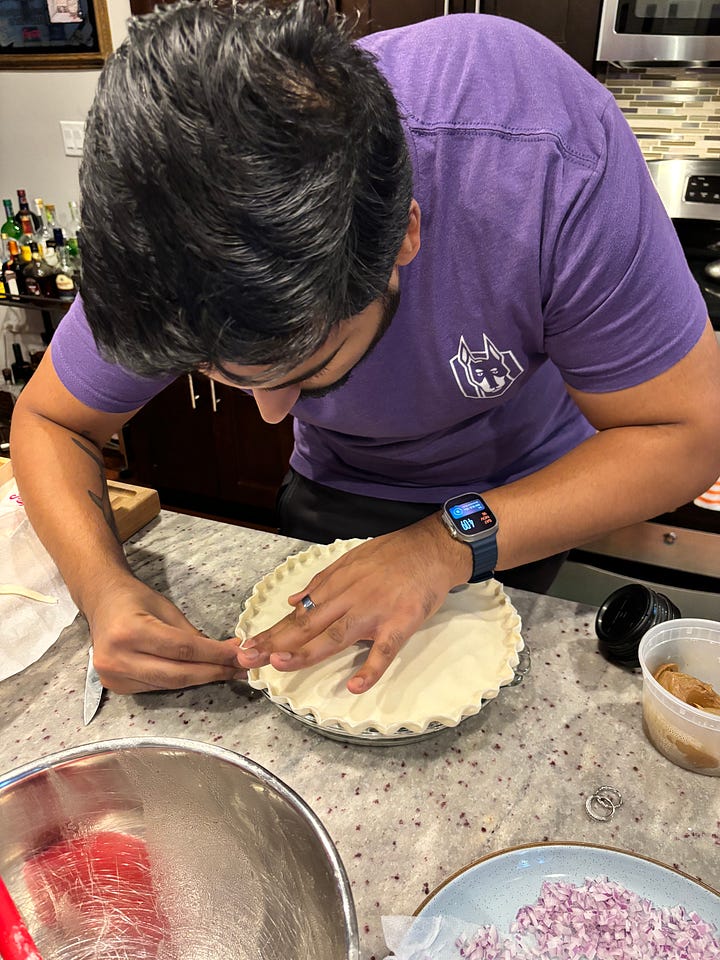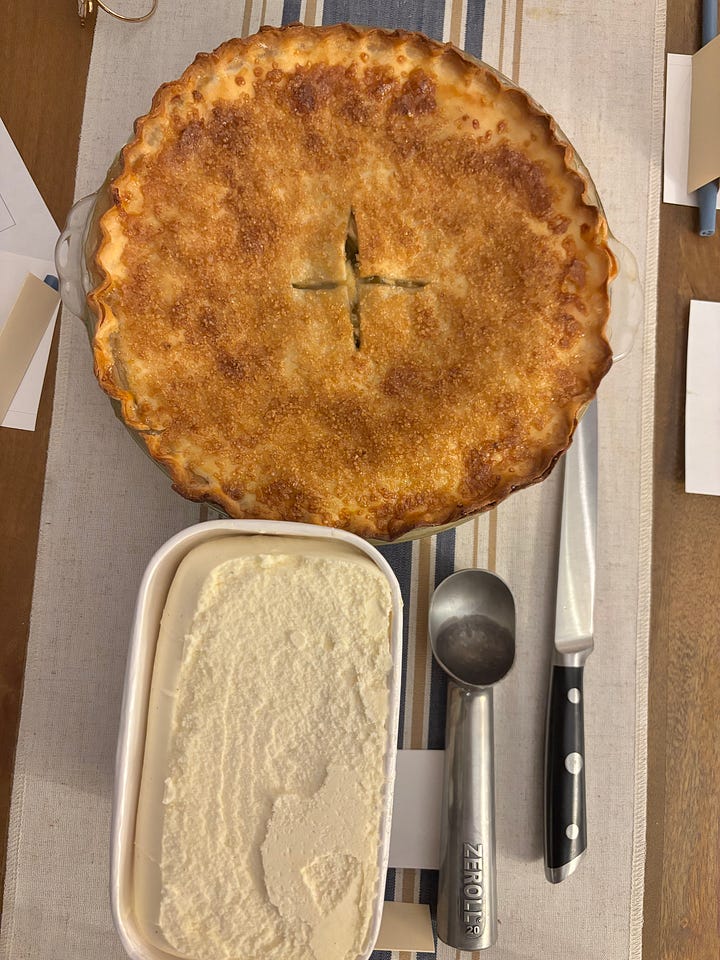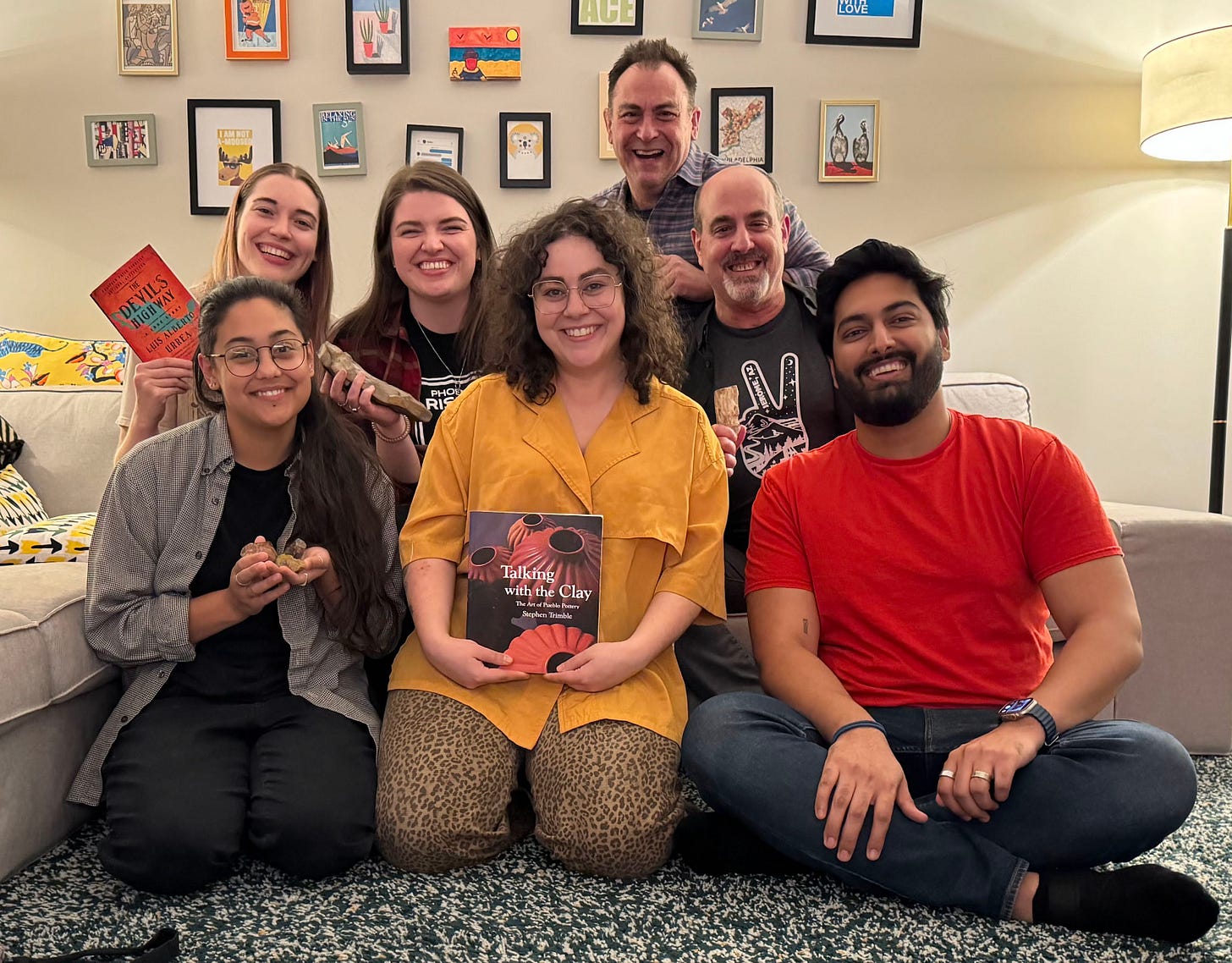When three of the guests for the Arizona dinner showed up wearing flannel button-downs, I thought nothing of it. It was fall, after all. Little did we know each of them had a nearly identical plan: a reveal of a state-themed T-shirt underneath as part of their prepared discussion item.
The first reveal felt unexpected and clever, the second a delightful callback. By the third, we were all in absolute fits of laughter about both the pattern and the fact that nobody had suspected a third button-down to be ceremoniously opened as we discussed how Pluto was discovered at Flagstaff’s Lowell Conservatory.
Let’s just say this: I’ll never look at a guest wearing a flannel the same way.
The menu
As compared to some other states, the list of Arizona recipes in America: The Cookbook is relatively small.
For reference, Alabama had 40 and Alaska had 32. Arizona? Just 18 options, only 7 of which were state-specific rather than regional.
Yet the choices were a bit more conducive to a cohesive dinner party menu. Arepas seemed like a fun appetizer, followed by an entree course with calabacitas (squash and Hatch Chile casserole) and sides, then bringing through the same chiles into a sweet-and-spicy apple pie for dessert.
Once again, however, sourcing became a bit of a saga.
Hatch chiles have become a familiar ingredient outside of the Southwest (I have to assume thanks in good part to Trader Joe’s jarred salsa and frozen Hatch Chile Mac & Cheese). But where to buy the chiles themselves—ones actually labeled with the Hatch Valley origin?
Next, a pot of beans would be a great make-ahead side dish for a dinner party, but all simplicity disappears when tracking down tepary beans, a legume indigenous to the Southwest that is among the most drought- and heat-tolerant crops in the world.
I was back in special-order land, which unfortunately often means Amazon for unusual ingredients, but even there, no tepary beans. Luckily, I found them online at Kalustyan’s just before my sibling Nik was coming down from New York to attend the Alaska dinner, so they could pick them up for me. Crisis averted, and exorbitant shipping charges also avoided!


Around the table
With drinks (including the original tequila sunrise, a subtle lime-and-blackcurrant drink completely unlike the orange-and-grenadine one you probably know) in hand, we immediately discovered that Arizona is the first state of the series that every guest had visited before!
Perhaps that’s unsurprising, given the popularity of sites like the Grand Canyon that entice visitors—including Harsh and me earlier in the year—but it was an exciting “first” of the project and gave our discussion of the state a deliciously personal flair.
I kicked us off by reading an excerpt and some learnings from The Devil’s Highway by Luis Alberto Urrea. One of the best nonfiction books I’ve read, it describes the harrowing journey of immigrating from Mexico into the US on foot through the Sonoran Desert. On top of absolutely brutal terrain and climate, the walkers also have to contend with sensors and other surveillance tactics of Border Patrol. Like in all border states, it’s hard to be in Arizona without feeling some level of tension about immigration—even if it’s not directly relevant to you—so beyond offering some new-to-me knowledge about these crossings, it also set the stage that we can talk about the good, bad, and ugly of a place, and that we can admit that our own firsthand experience somewhere isn’t necessarily the same as others in the same location.
While immigration is a topic that permeates the Arizonan consciousness, history is also omnipresent everywhere you go. Collectively, we undertook a journey through time, starting history as shown through nature.
Marria talked about the science of how petrified wood forms and endures. They even brought pieces of petrified wood to pass around the table in a presentation similar to show-and-tell that made me nostalgic for kindergarten. The Southwest’s vastness is unmatched and often hard for the brain to even fathom—and the same is true for its artifacts. How an item that we’re touching at my dinner table could’ve possibly existed thousands of years ago…absolutely mind blowing.
For somewhat-newer-than-ancient history, Claire shared what she had learned during an Arizona visit about traditional Hopi pottery, cochina dolls, and Pueblo architecture. I was especially glad to hear more about the indigenous roots of the state, not just because I’d tracked down an indigenous food for the meal, but because it’s another essential yet often overlooked part of what makes it unique.
Fast forward to the 19th and 20th centuries, where Rich walked us through the formation, rise, and decline of Jerome, Arizona, a former mining hub that built 88 miles of tunnels to carry materials by train and now is a super cute tourist town. David, as mentioned, described the history of Pluto’s 1930 discovery by an untrained astronomy hobbyist at Lowell Observatory. Another book recommendation for you here: Percival’s Planet by Michael Byers.
Verity, who had kicked off the dramatic shirt reveal trend of the evening, talked about one of her favorite pieces of present-day Arizona: the Phoenix Rising Football Club. As a former resident of the city who lived within walking distance of the stadium, the team became a cultural mainstay for her in a way that anyone who is a sports fan in Philly can understand.
As for the future? We covered a bit of that too. Harsh told us about Arizona State’s current de-extinction project that would resurrect the Woolly Mammoth (or, technically, a new species with all the same core biological traits) via stem cell research and genetic engineering. What’s old may be able to become new again. And it seems somehow fitting that it’s happening in Arizona, given its unique mix of ancient history’s persistence and modernity’s breakthroughs.
Taking risks
Back, briefly, to the food. I only mentioned in passing that dessert was both sweet and spicy. None of us, myself included, had any idea what to expect when we cut into it. And we were all pleasantly surprised by how the familiar met the unusual so beautifully.


Yes, yes, there’s a metaphor here for bringing people together in the same way. Everyone knew at least one other person attending, but the rest was a risk. Everyone knew apple pie, but what a novelty to have Hatch chiles inside too.
The next week Harsh and I, completely by chance, ran into Marria while they were selling their pottery at an art market.
“I’ve told so many people about our dinner!” they said, then revised: “I mean, your dinner.”
“No, it’s our dinner,” I replied, forming my hands into a circle to show it was collective.
Sure, I do the planning, and Harsh helps me cook the food. But we—all of us at the table—create the evening together. The meal is selected on behalf of the people attending, with considerations to their tastes. The conversation is what it is because of everyone’s individual contributions. They bring their openness, their vulnerabilities. They put forth their interests and share their perspectives. We all learn from each other and leave feeling like something special happened at the table, because it did.
I should mention here that Marria’s pottery looks a lot like petrified wood.
“I obviously had no idea what your art would look like, but I didn’t expect it to look like petrified wood!” I said.
“Even though I talked so much about my obsession with it?” they said, to which we laughed. I had been surprised–but only because I had no idea pottery could be created to look that way. From Marria, though, it made perfect sense, given the passion and knowledge they showed.
In this way, we both acknowledged that the dinner’s show-and-tell items weren’t just souvenirs. The wood was their offering to everyone there, an invitation to know more of who they are, a way to turn strangers into friends.
That’s what all of this is about. That, and hilarious tee-under-flannel reveals, of course.
New here? Learn more about the 50 States project.
Want the recipes? See the full menu.


